Sigma C 18-300 mm f/3.5-6.3 DC MACRO OS HSM
3. Build quality and image stabilization
In photos below you can see both Nikkors 18-300 mm VR and the Sigma 18-300 mm OS set at 18 and 300 mm focal lengths.
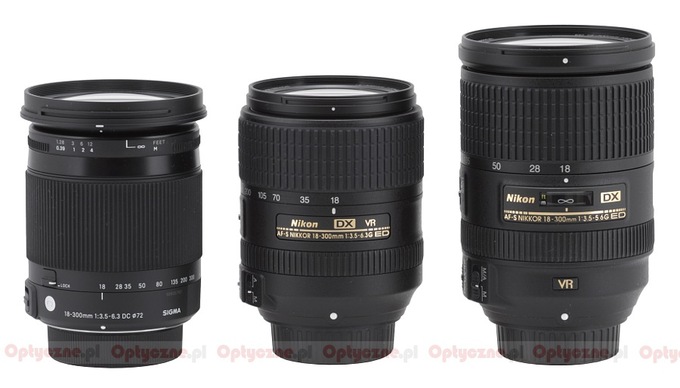 |
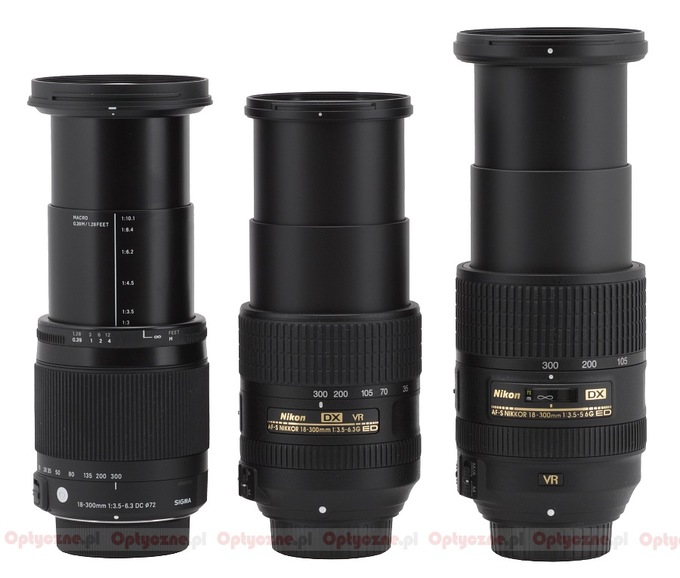 |
Please Support UsIf you enjoy our reviews and articles, and you want us to continue our work please, support our website by donating through PayPal. The funds are going to be used for paying our editorial team, renting servers, and equipping our testing studio; only that way we will be able to continue providing you interesting content for free. |
- - - - - - - - - - - - - - - - - - - - - - - - - - - - - - - - - - - - - - - - - - - - - - - -
The tested lens starts with a metal bayonet mount which surrounds a rear element of the lens, 19 mm in diameter. That element is situated on the same level as the mount with the focal length set at 18 mm. After passing to the maximum focal length the element hides inside the tube over 5.5 cm deep, revealing a well-matted and properly darkened interior. Still if you take a closer look inside you can spot some construction parts which are not blackened at all so the situation is not so perfect.
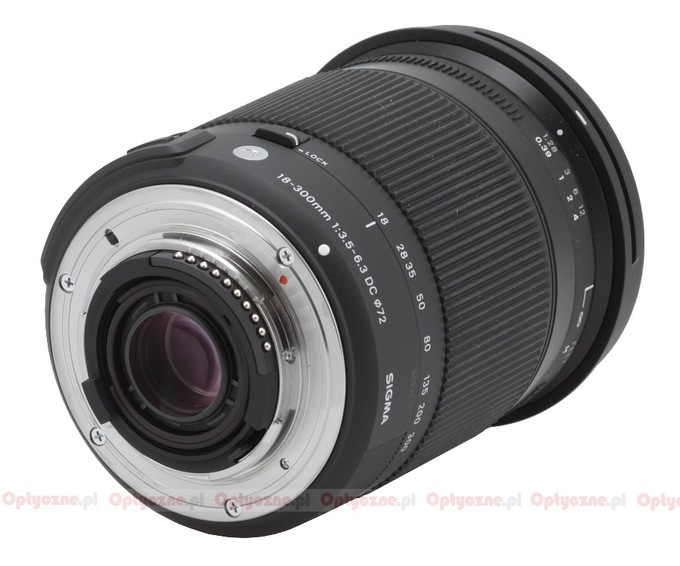 |
The proper casing of the lens starts with an immobile ring, 17 mm wide, on which you can find an inscription with the name and the parameters of the lens. On the left side of that inscription, looking from above, you see a “C” mark (meaning the lens belongs to Contemporary series) and an array of switches allowing you to choose the focusing mechanism mode (AF/MF) and controlling the optical stabilization (OS ON/OFF).
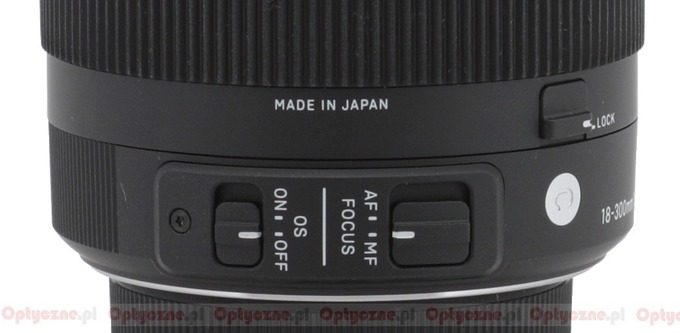 |
The next part is a zoom ring, as wide as 47 mm. Most of its surface is covered by rubber ribbing and below you can find focal lengths markings at 18, 28, 35, 50, 80, 135, 200 andá300ámm along with an inscription “Made in Japan” and a zoom lock switch, blocking the instrument at 18 mm focal length. Still the lens’s build quality is so good that we didn’t have to use it during our test because the Sigma didn’t have any zoom creep tendency even if we pointed it firmly downwards and swung quite vigorously.
The action of the ring itself is quite stiff, with two slightly slacker ranges: the 18-28 and the 150-300 mm.
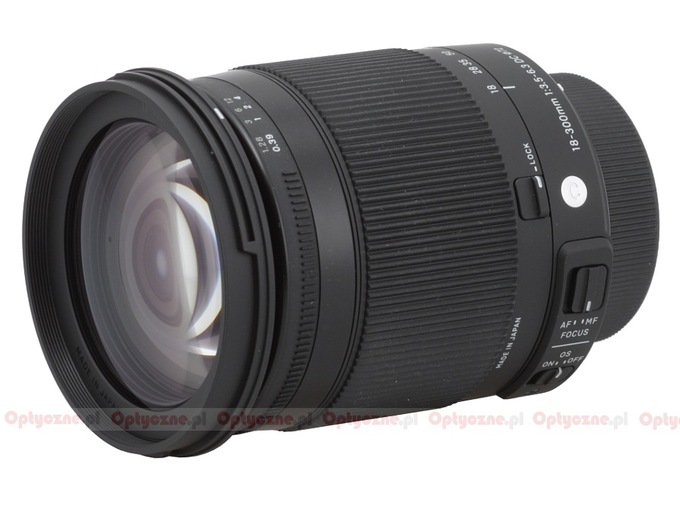 |
Further on there is a manual focus ring, 16 mm wide. On it you can find a distance scale expressed in feet and meters and a rubber ribbing. The ring can be moved only in the MF mode. Running through the whole distance scale takes a turn through about 45-50 degrees. Such a narrow angle makes it rather a dummy than a really useful tool.
The lens ends with a hood thread surrounding a non-rotating filter thread, 72 mm in diameter. The front element of the lens is 59 mm in diameter and around it you see a part of the casing with the name, parameters of the lens and an inscription “Made in Japan”.
When you pass from 18 to 300 mm focal length the front element system extends on a telescopic tube made of plastics. It is quite stable, without any side play. The dimensions of the lens increase from 98 mm to 185 mm. It’s worth mentioning here that the rival Nikkors 18-300 mm had one tube part made of metal. In the case of the Sigma plastic seem to be a prevalent material.
In the chart below you can find an interesting comparison – it shows how the relative aperture changes with different focal lengths. As you can notice the results of the Sigma are identical to those of the newer Nikkor 18-300 mm VR F/3.5-6.3.
|
|
|
||||||||||
|
|
|
|
|
|
|
|
|
|
|
|
|
| Nikkor 18–300 f/3.5–5.6 |
|
|
|
|
|
|
|
|
|
|
|
| Nikkor 18–300 f/3.5–6.3 |
|
|
|
|
|
|
|
|
|
|
|
| Sigma 18–300 f/3.5–6.3 |
|
|
|
|
|
|
|
|
|
|
|
When it comes to the optical construction, it is really impressive. You deal here with 17 elements positioned in 13 groups and it should be mentioned that there are as many as 4 FLD elements among them (with properties similar to those of fluorite), one low-dispersion SLD element and three aspherical elements. The rival Nikkor with the same parameters had overall 16 elements, including three made of ED glass and three aspherical ones. In theory the dominance of the Sigma seems to be unquestionable; will it be also so obvious in practice, though?
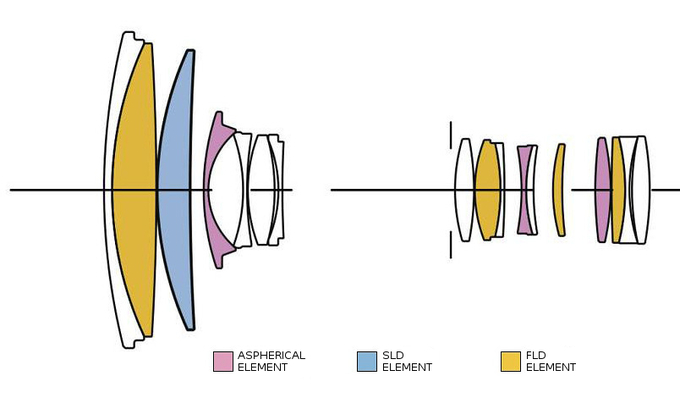 |
The buyers get both caps and a petal-type hood in the box.
 |
Optical stabilization
In this category the rivals of the Sigma, the Nikkors, fared pretty well - the older, faster and more expensive Nikkor 18–300ámm f/3.5–5.6áVR featured a stabilization system as efficient as 3.3 EV and the stabilization of the newer one was about 4 EV. How the Sigma compares here? In order to check that at 300 mm focal length we took several dozen photos with shutter speeds ranging from 1/320 to 1/4 of a second with the stabilization switched on and off. Then we calculated the percentage of blurred photos at every speed and presented the results as exposure time function graph, expressed in EV (with 0 EV being the equivalent of 1/250 of a second). The results can be seen below.

The maximum distance between both curves amounts to about 3.3- 3.5 EV and such is the efficiency of the optical stabilization system. The result of the Sigma is very similar to the result of the Tamron and the older Nikkor; it is also worse than the result of the newest Nikkor zoom lens. Still you shouldn’t complain too much – such an efficiency is able to make photography at longer focal lengths much easier.






